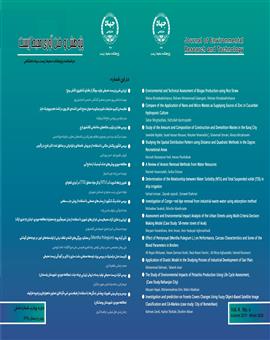بررسی اثرات زيست محيطي توليد پسته با روش ارزيابي چرخه حيات (مطالعه موردي: شهرستان رفسنجان)
محورهای موضوعی :مریم رجایی 1 , محمد رضا علمی 2 , مهین ملکیان 3
1 - دانشگاه یزد
2 - دانشگاه یزد
3 - دانشگاه یزد
کلید واژه: اثرات زیست محیطی ارزیابی چرخه حیات اسیدیته رفسنجان پسته,
چکیده مقاله :
در چند دهه ی اخیر با افزایش جمعیت، تولید محصولات کشاورزی افزایش چشم گیری یافته است. از آنجا كه اهميت حفاظت از محيط زيست در جوامع امروزي امري بديهي است، بنابراين اقدام و اجراي هرگونه برنامه نياز به دانش كافي و شناخت لازم از محيط زيست دارد. يكي از راههاي حفظ منابع طبيعي و دست يافتن به توسعه پايدار بويژه كشاورزي پايدار، ارزيابي زيست محيطي فرايند توليد محصولات كشاورزي مي باشد. روش ارزيابي چرخه حيات رویکردی مورد قبول براي ارزيابي اثرات زيست محيطي سراسر چرخه حيات يك محصول می باشد كه بر اساس دو مؤلفه ميزان مصرف منابع و انتشار آلاينده ها به محيط زيست محاسبه مي شود. در این مطالعه ارزیابی اثرات زیست محیطی تولید پسته از ابتدای کاشت تا درب مزرعه با استفاده از روش ارزیابی چرخه حیات(LCA) در شهرستان رفسنجان برآورد شد. اطلاعات اولیه به روش پرسشنامه و مصاحبه با کشاورزان منطقه جمع آوری شد. داده های جمع آوری شده با استفاده از پایگاه داده ایEcoinvent®3.0 و نرم افزار Simapro8.0.4.30 تجزیه و تحلیل شد. مرز سیستم، مزرعه و واحد کاری در این مطالعه یک تن پسته در نظر گرفته شد. نتایج این مطالعه نشان داد که استفاده از دیزل و الکتریسیته به عنوان منابع انرژی منجر به انتشار CO2، NOx ، SOx و فلزات سنگین به محیط می شود. تجزیه و تحلیل داده های پسته نشان داد که انتشارات ناشی از کودها در طبقات کاهش منبع، گرم شدن جهانی، سمیت برای انسان، سمیت برای آبزیان دریایی و فتواکسیداسیون شیمیایی بیشترین نقش را داشت. انتشارات ناشی از مصرف سوخت ها بیشترین اثر را در تخریب لایه ازون داشتند.
Life Cycle Assessment Approach is an accepted approach for assessing the environmental impacts of a product's life cycle, which is calculated on the basis of two components: the amount of resources consumed and the release of pollutants to the environment. In this study, the environmental impact assessment of pistachio production from the beginning of planting to the field door was estimated using Life Cycle Assessment (LCA) method in Rafsanjan. Initial data were collected through questionnaires and interviews with local farmers. The collected data were analyzed using Ecoinvent®3.0 database and Simapro8.0.4.30 software. System boundary, field and work unit were considered in this study. The results of this study showed that the use of diesel and electricity as energy sources lead to the release of CO2, NOx, SOx and heavy metals into the environment. Analysis of pistachio data showed that emissions from fertilizers had the highest role in source reduction, global warming, toxicity to humans, toxicity to marine aquifers and chemical photosynthesis. Emissions from fuel consumption had the greatest effect on the depletion of the ozone layer.
1- Blengini, G. A. & Busto, M. (2009). The life cycle of rice: LCA of alternative agri-food chain management systems in Vercelli (Italy) . Journal of environmental management, 90(3):1512-1522.
2- Brentrup, F. Kuster S, j. Kuhlmann, H. and Lammel, j. (2001). Application of the live Cycle Assessment methology to agricultural production: an example of sugar beet production with different Froms of nitrogen fertilizers. European journal of Agronomy, 14:221-233.
3- مجلس شورای اسلامی ـ (1388) ـ پایگاه اطلاع رسانی مرکز پژوهش های شورای اسلامی ، گزارش مرکز پژوهش ها درباره چگونگی اصلاح الگوی مصرف کود ، سم ، بذر و نهال در بخش کشاورزی ایران www.Majles.ir .
4- (Danni chang a, C.K.M Lee b,*, Chun- Hsien Chen . Review of life cycle asseassment to wards sustainable product development. Journal of Cleaner Production. 83(2014), 48-54
5- (Rebitzer G,EKvall, T., Baumann, H., 2005. Life cycle assessment: expectations, drawbacks and perspectives. J. Clean. Prod. 1 (3-4), 131-137.)
6- (Hunt, ,R.G., Franklin, W.E., 1996. LCA how it came about personal reflections on the origin and the development of LCA in the USA. Int. j. LCA 1(1), 4-7.)
7- (Fava, J.A., Denison, R., Jones, B., Curran, M.A., Vigon, B., S., 1991. A Technical Chemistry, Framework for Life-cycle Assessment. Society of Environmental Toxicology and Washington, DC, USA.)
8- Ekvall, t., 2002. Cleaner production tools: LCA and beyond. Journal of Cleaner Production. 10(5), 403-406.
9- Russell, A., Ekvall, T., Baumann, H., 2005. Life cycle assessment e introduction and overview. J. Clean. Prod. 13(13-14), 1207-1210.
10- Avraamides, M.& Fatta, D.(2008). Resource consumption and emissions from olive oil production: A life cycle inventory case study in Cyprus. Journal of Cleaner Production. 16:809–821.
11- Hokazono, S. Hayashi, K.& Sato, M. (2009). Potentialities of organic and sustainable rice production in Japan from a life cycle perspective. Paper presented at the Agronomy Research.
12- Blengini, G. A. & Busto, M. (2009). The life cycle of rice: LCA of alternative agri-food chain management systems in Vercelli (Italy) . Journal of environmental management, 90(3):1512-1522.
13- میرحاجی، ح ـ خجسته پور ،م.ح ـ مهدوی شهری ،س.م ـ(1391)ـ ارزیابی اثرات زیست محیطی تولید چغندر (Beta Valgaris.L) با روش ارزیابی چرخه حیات (مطالعه موردی : مزارع استان خراسان جنوبی) . نشریه بوم شناسی کشاورزی ـ جلد4 ـ شماره 2، ص120-112.
14- Isermann, K. (1990): Ammoniac Emissionen der Land wirtschaft, ihrer Stickstoffbilanz- und hinreichende L6sungsansfitza zur Minderung-Bundes for schungsanstalt liir landwir tschaft(FAL), Braunschweig, Germany.


